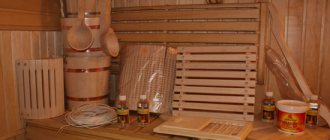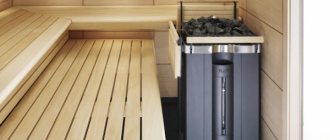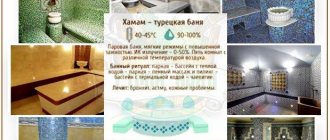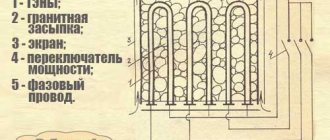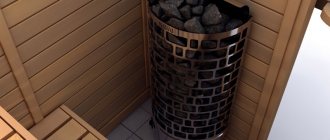How to install?
There are two main options for installing the system - connecting a structure with a supply of cold, contrast water or without an automation process.
In the first case, it is necessary to install a water supply system and create a water supply and locking device so that the bucket does not overfill. In the second example, installation will not cause any difficulties. You will need to install the bracket and bucket. If the dousing process is periodic, it is advisable to choose the 2nd method of attaching the system. After assembling a structure intended for water procedures, before use it is necessary to fill a full bucket of water and wait several hours for the wood to swell and block the connecting gaps. Also, a wooden container should be treated with a special varnish to ensure guaranteed protection against leaks and other external factors.
How to choose a dousing bucket for a bath, see below.
How much does a bath font cost?
If we compare materials, the most expensive models are wooden, they are three times more expensive than plastic. A larch bowl per cubic meter costs approximately 45 TR, an oak bowl - 110 TR, a cedar bowl - 70 TR, a polypropylene bowl of the same size - 20 TR. By decorating plastic with wood, we get a big increase in price. If you do the installation and cladding yourself, it will be profitable and convenient.
It is difficult to propose a specific model. The production is so individual and unique that the cost can only be discussed as an average. If you choose a budget built-in plastic container, look at the “ElitePolymer” models, where the price tag starts from 20 tr.
The best traditional herbal barrels (single or double) are produced by RosKedr, starting at a price tag of 35 thousand rubles. Glued varnish at a convenient price can be found at BentWood, where the price tag starts from 27 thousand rubles.
How to install a hot water tank in a washing room?
So, how to properly install a tank in a bathhouse? If the water in the washing room comes from a tap, under pressure, you need a closed water supply system. The most ideal option for this is considered to be a stove with a coil inside, and a tank will be connected to it. However, the following method can be implemented: the tank will be suspended on the stove itself.
A properly connected sauna tank will look like this in a sauna: the water in the register heats up and rises into the tank, where it gradually cools down and soon drops down into the register. This is how circulation occurs, and in order to improve it somewhat, it is better to take water from the return line - although this is not very convenient, since in this case you will have to wait a long time until the tank heats up normally.
But you can use water as soon as the stove is heated. However, it is more thoughtful and effective if a full-fledged ability to switch water intake from direct to return is thought out - this is much more convenient. If the entrance and exit to the tank is made from below, then the circulation will be somewhat slower.
And the diagram of such a process itself will look like this:
- The tank is mounted in the steam room, precisely under the shelves, and is connected by pipes to the stove coil.
- In the tank, for stable circulation, the upper outlet is connected to the upper outlet of the coil, and the lower one is connected to the bottom. Hot water will be discharged from above, and cold water will be discharged from below.
- A safety and check valve is installed at the cold water inlet - it is also called a blast valve.
- The automatic firing pressure of the explosive is set.
This whole structure will work in this way: the filled tank will be heated through the coil, and when warm water is consumed, it will automatically be filled through the cold water supply. As the cold water heats up, if it is not used yet, this pressure will constantly increase, and when it reaches its critical point, an explosive will automatically go off, releasing all the pressure.
Finally, you should remember that the most important thing when installing and using the tank is to follow all the installation features described in the instructions for the tank. In addition, you need to adhere to safety measures when creating a tank yourself. If you follow the operating instructions, the sauna tank will serve you flawlessly and for a long time.
Features of installation and connection step by step
It is not difficult to install a water tank with your own hands.
Let's look at each stage separately:
- If the stove is already installed, remove the section of pipe extending from the stove into the ceiling;
- We weld a piece of pipe 8-10cm long to the outlet of the furnace.
- If the pipe built into the tank does not match the diameter of the chimney, an adapter is mounted on the installed section of the pipe;
- We install the tank. The distance between the top cover and the ceiling should be 20-25cm;
- If necessary, an adapter is also installed in the upper part;
Important! Pipe connections are made using crimp clamps, but the joints should be additionally treated with a special sealant. Otherwise, if gases penetrate through cracks in pipe joints and there is insufficient ventilation, a person may suffocate.
A few important operating rules:
- The bathhouse is not only a recreation area, but also a place of increased danger, especially for children. Therefore, if possible, it is better to install the tank on the pipe as high as possible, optimally in the attic. You need to pour boiling water extremely carefully.
- The system should be filled with water until it is flooded; heat without water will destroy the welds.
- Do not leave water in cold weather. If the water in the system freezes, deformation is inevitable.
Sauna stoves equipped with a remote tank
One of the most convenient options for heating water is to install remote tanks. Such a tank can simultaneously cope with two tasks:
- supply of hot water to the washing compartment of the bathhouse;
- provision of hot water to sinks located in other rooms.
The great advantage of the installed remote tank is that its presence permanently eliminates such an unpleasant situation when the firebox brings the water to a boil without having time to completely warm up the entire volume of the steam room, which results in the room being filled with clouds of moist steam.
In addition, a remote tank is the only correct solution for those who want to acquire not a Russian bathhouse, but a sauna, the air of which must be extremely dry.
Typically, a remote tank made of stainless steel should be installed in a room located next to the steam room. Heating of the water poured into it is ensured using a heat exchanger mounted in a sauna stove and connected to the tank using pipes.
To circulate water without the use of pumps, the bottom of the tank must rise above the heat exchanger, sometimes called a register, by half a meter or a little more. To ensure that water circulation never occurs, it is necessary to:
- install connecting pipes not exceeding 3 m in length;
- for installation, choose pipes with a diameter of one inch or more;
- ensure that there is no sagging of the pipes and their slope is about 2-5°.
If one of the above conditions is not met, a pump may need to be installed.
Speaking about heat exchangers, it should be noted that for stoves of the “Zhara” brand, for example, they are given a cylindrical shape, and for their manufacture, stainless steel is used, the thickness of which is as much as 5 mm.
Easy-to-use and practical remote tanks, however, also have disadvantages, namely the complexity of their installation and connection. In addition, we should not forget about the significant costs associated with the purchase of rather expensive water heating registers-heat exchangers, pipes, taps, and connecting hoses.
The listed disadvantages of remote-type tanks are largely compensated by the convenient opportunity to equip a shower or connect a battery to the tank that can heat a locker room or shower in the winter cold.
Device Features
At the exit of combustion products, the temperature reaches higher values. The water here is heated quickly from a metal chimney, without the use of additional heat sources. The heating rate is explained by the high thermal conductivity of the metal and the large heat transfer area.
Since the tank is located in the upper part of the room and directly above the stove itself, the boiling water does not cool down for a long time .
Advantages
Main advantages of the design:
- Economical - water is heated during the heating of the room, using the maximum heating zone of the stove.
- Efficiency – water is heated in the shortest possible time and the temperature is maintained for a long time.
- Convenience - the tank on the pipe does not eat up the space of the bathhouse, which is especially important for small rooms.
- Ergonomics - the tank capacity on the pipe can be significant, but its heating time will be short. The design is such that by increasing the volume of the container along the length of the pipe, the heating area of the water simultaneously increases.
- The service life of the chimney increases, since water prevents it from burning out.
We recommend that you familiarize yourself with: HDPE pipes for water supply installations
Flaws
Difficulty controlling the water level during the heating process; inconvenience caused by the need to add water when the stove is hot. These disadvantages are inherent in the simple design of the tank in the absence of communications, through which it is much easier to regulate the amount of water.
Installing a tank on a large-volume pipe presents certain difficulties. This design with water exceeds the 100 kg mark, which requires special fastenings.
The main disadvantage is the inability to obtain dry steam; the water in the tank on the pipe will boil, creating additional humidity in the room.
Notes from experienced bath attendants
Those who constantly encounter bath products know all their best sides and problems. These little things are not talked about on the manufacturers’ websites, but they are useful for those who are planning to purchase a hot tub. Here are some subtleties from the professionals.
- The most convenient height option is 1.2 m.
- Ensure that the tank is in a vertical position. Provide it with steps, benches, and handrails. Eliminate slippery surfaces (place mats, towels).
- The most reliable tree is larch. This can even be installed outdoors. Next in terms of biostability are oak, cedar, and pine.
- If you choose one with a stove, look for one with an internal one, it is more efficient. Stainless steel with a thickness of at least 2 mm is guaranteed not to burn out or rust.
- A new wooden barrel may leak when first filled, this is normal. Within a day, the wood will swell and the flow will stop. If this does not happen, change the product, this is a defect.
- The wooden font must be constantly filled with water, which must be changed periodically. The water must be clean and fresh. Polypropylene models are absolutely unpretentious in everyday life.
- Do not place a wooden tank near heating sources, as this may cause the wood to dry out.
- Proper care of a wooden tank:
- cleaning with non-abrasive detergents;
- prevent water from freezing (outside);
- protect from direct sunlight;
- tighten the nuts on the hoops in a timely manner, preventing leakage (check once a month);
- Don’t forget to change the water, be sure to drain it to avoid the appearance of green mold.
9. It is practical, convenient, and useful to have a drain hole into the sewer, as well as a filter for water purification. Other bells and whistles can be added or not.
By the way! Having studied the materials, handy owners can build a font themselves. This applies to concrete street, metal, polypropylene (inside or outside the sauna) options. If you are not a carpenter, you can buy a wooden barrel in a store, and do the rest yourself. You will need skills in constructing a pit, the ability to lay concrete, lay tiles, and connect electrical and gas equipment.
Why do you need a font for a bath-sauna if there are snowdrifts in winter and a lake in summer? It is safer than natural sources, the water is cleaner, has a controlled temperature, and frees you from long distances in negligee to the reservoir and back. But in general, a bathhouse without a font cannot be considered a real Russian bathhouse, giving health, mood, and pleasure. Choose, use and improve your health with pleasure.
What materials are used
The sauna tank is made of metal, but the specific material is selected taking into account financial capabilities, volume and heating characteristics. The most popular designs are:
- Cast iron. Main advantages: high strength, durability, while the water temperature remains for a long time after the furnace has stopped firing. At the same time, the cast iron container warms up slowly, and most importantly, it has a large mass, which requires reliable support when installing the structure.
- Steel. The cheapest and most accessible material used in economical structures. The water in a steel tank heats up quickly, but also cools quickly after the fire stops. The most important disadvantage is corrosion destruction, which requires protective covers. One of the common options for eliminating this drawback is the use of enamel tanks. However, when choosing this material, it should be taken into account that with local damage to the enamel, accelerated corrosion begins at the source of damage.
- Stainless steel. A tank on a pipe for a stainless steel bath is considered the most common design, because... optimally combines cost and durability. The material is more expensive than ordinary steel, but is not subject to corrosion and has a long service life. At the same time, stainless steel can be welded, and you can make a tank from it yourself.
The remote design of the tank is in more gentle conditions. Extreme temperatures (400-500 degrees) only affect the heat exchanger located on the chimney. The walls of the tank itself do not heat above 70-80 degrees, which means it can be made from different materials. In addition, it is usually placed on the wall, where the risk of damage is reduced. In such conditions, decorated enamel containers become very popular. Supply pipes for a remote tank in a bathhouse can be made of metal, composite material and heat-resistant plastic
It is important to ensure their thermal insulation
Remote heat exchanger for a bath
The simplest and most affordable way to make a tank for a bath is the built-in version, when it is hung on the chimney. It’s not for nothing that such a system is called a samovar in everyday life, because it uses the same principle, i.e. heating the water with hot smoke rising through the inner pipe. Such a tank is installed during the construction of the stove or installed by dismantling a section of the chimney.
In the selected location, a pipe is mounted on brackets, so that the gap between the outer diameter of the chimney pipe and the inner body of the tank pipe provides the required volume. The base is welded at the bottom of the tank body, and all gaps are sealed with heat-resistant sealant. To drain water, an outlet with a tap is welded (Fig. 1). The upper part of the tank is closed with a lid.
Figure.1 Installation diagram of a bath tank
In principle, the tank body can be made in a rectangular shape for the required capacity. The wall thickness is selected taking into account the volume. To make a small tank with a volume of about 50-55 liters, you can use a metal sheet with a thickness of 0.9-1.2 mm, and for a container of more than 70-80 liters you will have to use metal with a thickness of at least 1.5 mm.
If there is a water supply to the bathhouse, then a remote system is more suitable. It is shown in Fig. 1. In this case, a coil is mounted on the chimney. The hot water exits towards the remote tank from above, and the coolant returns, respectively, from below. During installation, it is necessary to install the necessary shut-off equipment (valves, taps, taps).
When installing a tank in a bathhouse on a chimney pipe, you will need the following tools and equipment: a welding machine and electrodes with a diameter of 2.5-3 mm, a grinder, a hacksaw, an electric drill, a hammer drill, a hammer, pliers, a set of keys, a caliper, a tape measure.
The sauna tank on the chimney pipe allows you to have a supply of hot water without unnecessary fuel consumption.
Such a system uses the energy of futile smoke, which gives a significant economic effect. A system of different designs can be made and installed with your own hands.
Installing a tank in a brick oven
You need to install a water tank in a bathhouse in a brick oven during the process of laying it. This often happens on row 10, depending on the oven model. When laying out a row, it is necessary to leave an opening for the tank, a recess. The dimensions of such an opening depend on the size of the tank itself, the main thing is that they must exceed the dimensions of the tank by several mm. To compensate for all thermal expansions.
Below, a plumbing tap crashes into the tank. In this case, hot water will be drawn directly from the bathhouse. Or it is possible to cut in a pipe, connect a pipe, and thus drain water into the washing room.
When the furnace masonry reaches the upper boundaries of the tank, we lay 2 metal strips on it, which will allow you to safely cover the tank with bricks. Then we close the tank and follow the order of the oven.
TOP 5 best water tanks for baths
| Photo | Name | Rating | Price | |
| #1 | Teplodar Parus | ⭐ 99 / 100 3 — votes | Find out the price | |
| #2 | Ferrum | ⭐ 98 / 100 | Find out the price | |
| #3 | MetalStroy | ⭐ 97 / 100 4 — votes | Find out the price | |
| #4 | Volcano | ⭐ 96 / 100 1 — vote | Find out the price | |
| #5 | Horizontal | ⭐ 95 / 100 4 — votes | Find out the price |
Which water tank would you choose or recommend?
Take the survey
Peculiarities
A modern shower bucket for a bath is not much different from previous models, which were actively used by our grandfathers and great-grandfathers when they expressed a desire to improve their health. Essentially, this simple device is called a “shifter.” In order to increase comfort, buckets were and continue to be made with a rope and chain. Such a device is installed mainly in a specially designated place for dousing - in the washing room, next to the steam room. Why is such a remarkable device found in many village baths if there is no lake, river or pond in the immediate vicinity? A useful activity - dousing with cold water contains many benefits for the soul and body:
- the immune system is strengthened;
- blood circulation functions accelerate;
- skin color improves;
- the skin becomes firm and elastic;
- toxins are removed from the body;
- rejuvenation processes are activated.
A seemingly simple procedure gives an amazing effect. In addition to the above advantages, a person receives a charge of vivacity, energy, and good mood for a long period. The main advantages of the cold water dousing device:
- simple production in a minimum amount of time;
- use without other aids;
- allocation of a minimum number of free square meters;
- saving money (for dousing there is no need to build a shower, swimming pool, font).
The simple design can be installed anywhere in the bathhouse where it is possible to organize a water supply, as well as drain dirty waste into a sewer canal. The dousing device consists of three key elements:
- classic bucket with hoops;
- rotation system;
- wooden brackets.
The assembled mechanism, attached to the wall, is a U-shaped structure, in the middle of which, above the center of gravity, there is a bucket on the axis with a hanging metal chain and a handle at the end. At a certain point, the bucket is filled with clean, cold water. A man stands under an upside-down bucket, pulls the chain towards himself and douses himself.
Most craftsmen and lovers of this useful procedure improve the design and ensure that after the dousing is completed, the water automatically flows back into the empty bucket. It's not difficult to improve a simple device.
Remote, built-in or on a pipe?
Tanks for baths can be built-in, remote, or on a pipe - and each has its own pros and cons. Compare and evaluate which one is right for your bath.
Advantages of a tank built into the oven
Once upon a time, water tanks for the bathhouse were only built into the stove - so that the lower part of the boiler was placed in the upper part of the firebox - the hottest one. And the bottom of the tank in this case is in direct contact with the stove fire. Water can be drawn from such a container directly, or it can be discharged through the built-in tap.
Remote tank for a bath: pros and cons
Thanks to the ability to install a heat exchanger in the oven, the tank itself does not need to be tied to a specific place - it can even be installed in a washing room. According to the known laws of physics, cold water will fall into the heat exchanger, and hot water will rise back.
Tank on a pipe - hot water without problems!
But it happens that the bathhouse is used not for two or three hours, but for the whole day - for example, when they wash in it, but the time after the fire has already passed. Then the ideal option is a tank on a pipe in which the water will be constantly heated to the desired temperature. This is on the pipe through which the smoke comes out of the stove - and its temperature can reach 500? C. Such tanks can be quite large - after all, the heating area of the pipe is quite large, and the water will heat up quickly and evenly.
There is one more advantage of this design - in such a bathhouse, smoke leakage through a crack in the pipe is impossible, because The tank in this case serves as a kind of fuse.
Materials
If a lover of water treatments decides to independently make a simple device for healing the soul and body, such a craftsman will need materials to create a bucket:
- 2 metal headbands 4-5 cm wide;
- boards of wood species - larch, cedar, linden, oak.
The tree species listed above have good resistance to the negative effects of water. They will not crack or dry out for a long time. You will also need first grade woodworking products with a thickness of at least 1 cm to assemble the bracket. In order to increase the service life of a wooden bucket and improve its tightness, many lovers of cold, contrast showers install a special plastic liner inside. If you use an ordinary plastic bucket, such a banal attribute will not add attractiveness to the dressing room, steam room, or washing room.
In general, there are a lot of useful devices for a bathhouse, in terms of configurations. They differ, first of all, in the design of the bracket, bucket, as well as its container, and the use of various materials - a chain, a durable cord, a functional handle.
Made of stainless steel
When assembling the entire system, stainless steel sheets are necessary to strengthen the bucket. Two rims, cut from such sheets 4-5 cm wide, are covered with pre-made wooden boards with a fixed bottom. Also, stainless steel is often used to create brackets, which increases the reliability of the entire structure. In addition, a stainless steel chain is used. It looks much more attractive than a durable cord. The simplest designs use ordinary galvanized steel buckets. If you need to quickly create a simple dousing system or don’t have time to get sophisticated in design, you can use just such a bucket, but the brackets are also made of stainless steel.
Made of wood
Buckets for dousing, made from wood, are the most beautiful and aesthetically pleasing. To make such a container, you must first create templates for the sides. Then you should cut the prepared parts according to the template and process them using a plane and sandpaper. It should be remembered that the boards for the sidewalls need to be given a slightly trapezoidal shape, that is, the end planes must be ground at an angle of 3 degrees in such a way that when assembled, you end up with a bucket. To form the bottom, you will need to make a 4 mm recess on each plank. Leave 4 cm from the bottom edge.
Next you should prepare the parts and cut out the cover for the bottom. Use a hammer to give the metal rim at the bottom of the tub a rounded shape. Drill holes for riveting at the ends at the joints. Attach the rim to the bucket. You can make the top rim in a similar way. It should be at a distance of 10-15 cm from the bottom rim. When the tub is ready, the sharp edges must be cleaned with sandpaper.
Keys to choosing a hot tub
If you want to install a contrast tank in your bathhouse, answer a few questions that the sellers will ask.
1. How many people should fit: a question of tank dimensions and volume. The font with a diameter of 1.5 m can accommodate 4-6 people. If there are two people washing and steaming, you will end up wasting water and electricity.
2. Where it will be installed: outdoor or indoor - they have different characteristics. If options are available, communications will be required. Outdoor ones can be dimensionless, internal ones - the area of the sauna is taken into account.
3. Installation option:
- free-standing, ready for use immediately;
- built-in is just a bowl that requires a deepening (pit), installation, cladding, but gives a chance for a creative approach.
4. Shape: round, oval, corner, rectangular. Non-standard is possible - in the style of modern design. A vertical (standing or sitting) compact barrel will look awkward on the lawn of a spacious area. A large oval one, taking up half the space, will also not please you, complicating the bathing process.
5. Material: here consider quality, usefulness, price tag, durability (you may not need it for a hundred years, inexpensive enough for a short time).
- wood: warm, environmentally friendly, healing effect;
- plastic: does not rot, does not collapse, you can choose shapes, sizes, easy to clean;
- composite: ideal for outdoor use, super durable.
6. Bowl coating:
- without coating: a special smell, wood substances dissolve in water, making it medicinal. Require special care. Not recommended for outdoor use.
- waterproof coating: easy to care for the container, no wood smell and no healing effect, strong due to glued rivets. Installation is possible even in an apartment.
7. Rim mount:
- hoops with a screw connection: fine adjustment, the ability to tighten to ensure tightness, used on traditional glueless models;
- rivets: fixed tension, suitable for varnished products, plastic.
8. Water heating, frequency of use:
if used frequently, it is better to use an electric heater; high degrees are not required here. a wood heater indoors will require smoke venting, possibly remodeling
Pay attention - built-in or attached oven (each option has its own advantages and disadvantages). Outside, a live fire and the pleasant warmth of the stove create additional relaxation and relaxation.
a gas heater is the most economical, but not every bathhouse has the conditions for safe installation. These questions need to be thought through in advance.
9. Additional equipment:
- aero-hydromassage systems;
- thermal insulation;
- water filtration and disinfection systems;
- different types of water heaters;
- backlight;
- touch control.
These points are not the most important when making an initial decision, but it is better to take them into account in advance. Over time, there will be a desire to improve something, to retrofit it, but everything is installed in such a way that you can’t get under it.
Basic criteria when choosing a hot water tank
There must be two containers in the bathhouse. One is set for cold, and the second for hot. If the requirements for the first option are lower, then when installing the second option, many nuances should be taken into account, including resistance to high temperatures
Therefore, when choosing the right model for hot water, it is important to consider the main parameters of the tank, which include:
- type of construction;
- the material from which the tank is made;
- fastening method;
- tank volume.
In order to determine the required size of the model, you need to calculate how many people will visit the bathhouse. If one visitor uses an average of 2 buckets of water (16–20 l), then four people need a tank with a volume of 65–80 l. Based on these calculations, we will choose the type of construction.
Built-in options directly depend on the size of the oven itself. And if you need a large capacity (and it cannot be installed directly into the firebox), it is better to choose a remote tank. The installation method is calculated based on the area of the steam room, the dimensions of the container and the performance of the stove.
Choose the heating method that best suits your sauna. That is, whether the water will be heated by a stove or using a special heating element. You can increase the service life of the product by choosing an enameled design. But there is also a nuance here. Any damage to the enamel will lead to metal corrosion. Therefore, to prevent rust, it is best to choose stainless steel models.
Also important is practicality and convenience of location. Here it is necessary to calculate the installation location and the height at which the tank will be located. These calculations will not only make it convenient to collect water, but also significantly reduce the risk of burns.
Decisive factors when choosing a product.
- Water heating speed.
- Strength and durability of the structure.
- Easy to install.
- Sufficient tank volume.
- Unit cost.
The significance of these indicators is individual for each person. The owner himself must take into account the main points. After weighing all the pros and cons, carefully considering the features of each design, and also studying the operating conditions, you can choose a good model. It will become not only practical, but also a durable option for a bathhouse.
Mounting tanks used with sauna stoves
The name of such tanks is due to the method of their installation, since they are placed directly on top of the firebox. It is quite clear that mounting tanks can be purchased in specialized stores, but often craftsmen make them with their own hands, using the materials at their disposal: a piece of thick pipe, sheets of metal, etc.
When making such a tank on your own, special attention during the work and installation process should be paid to the strength of the seams and the tightness of the tank
The bottom of the tanks may be uneven or have a recess to ensure its secure installation on the firebox. You can also either purchase such models or make them yourself.
Fonts are different
A small container with hot or cool water, into which one plunges after a sauna or steam bath, can be of any type and size, it depends on capabilities and preferences. The ideal shape is round or round-vertical.
Why round is better:
- there are no corners, the water has a single temperature;
- contact with the container is minimal, most of the skin participates in heat exchange.
Oval and rectangular containers are quite suitable. For small baths, a corner tank will be convenient. The average volume is about ten cubic meters of water.
The appearance of the containers varies, it depends on the design, height-width, materials. It can be designed for two or three; there are double models, concrete barrels, and micro-pools. Material - from wood to concrete, it depends on imagination and price tag. Most modifications can be used in a country house, in a cottage (private house), in a yard, and even in an apartment.
Wall-mounted tanks for sauna stoves
The convenience of stoves designed for the use of hanging tanks is that water heating tanks can be easily installed and also easily removed. As a rule, their suspension is provided using loops and hooks. Like all other water tanks, they are made of stainless steel. They include hatches for filling with water and taps that ensure the use of already heated water.
The Vravra range of stoves includes several products designed for the installation of wall-mounted tanks.
A significant drawback of such designs is that those steaming can get burned on their hot walls, and it is impossible to arrange a shower when using such tanks. In addition, heated water can boil in them, causing abundant formation of steam in the steam room that is not yet fully heated. True, the last problem can be solved in the following two ways:
- hanging the tank a little later;
- Periodically draining the hot water and refilling the tank with cold water.
The convenience of wall-mounted tanks is that they are ideal for retrofitting existing furnaces. They are convenient in small spaces and in combination with small stoves. They, like the mounted tanks, are easy to rinse and clear of accumulated scale.
An excellent system developed by specialists. Their tank can be used both as a mounted or remote one, but subject to the purchase of a water heating register and the installation of a water supply circuit.
How to choose?
To begin with, you need to decide where the tank will be located - directly above the pipe, or it will be a remote structure located in the attic.
Installing a container in the attic is convenient, but not always possible - it all depends on the design of the roof and the possibility of supplying and discharging water.
Calculating the volume
The required volume of liquid is calculated from the norm of 15-20 liters per person plus 10-15 liters in reserve. For example, if a family of 2 people periodically washes in a bathhouse, then a tank of 50 liters will be enough. A family of 4 people will need a capacity of 80-100 liters.
Type of material
Pros and cons of steel, cast iron, stainless steel:
- Cast iron
Cast iron containers are heavy, they are inconvenient to install, the water in them heats up slowly, but remains hot for a long time;
- Galvanized iron
Containers made from it last longer than steel ones, but over time they rust and burn out;
- Steel
Due to their high thermal conductivity, steel tanks heat up quickly and cool down just as quickly. The main advantage is the price, the main disadvantage is the low service life;
- Stainless steel
They combine all the advantages of iron products with high corrosion resistance.
Enameled products are found in stores. They are more durable than uncoated steel tanks, but are susceptible to chips, in place of which pockets of corrosion form.
